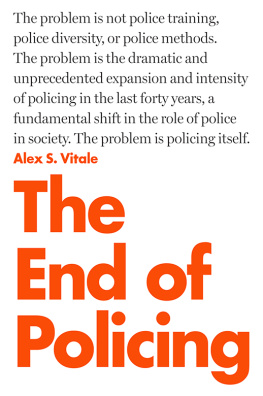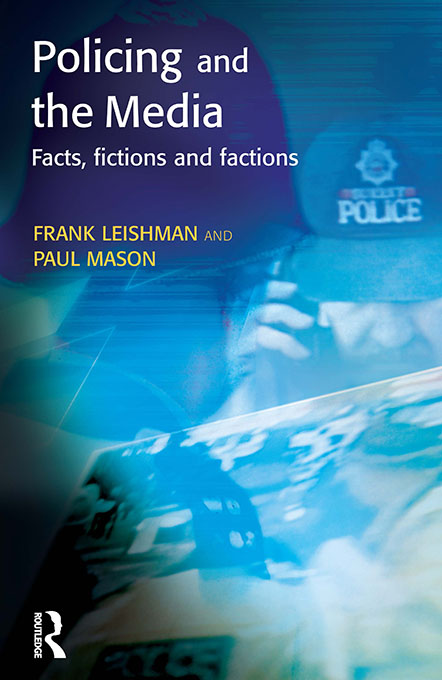Reality, realism and representation
In introducing a special media-focused issue of the often under-celebrated Criminal Justice Matters , Kevin Stenson and Hazel Croall observed in their editorial:
The media are not simply neutral conduits of information about crime; indeed, the institutional arrangements that organise the media and the rhetorical forms through which crime is represented can play a vital role in shaping and reflecting our deepest personal and cultural fears about crime and insecurity. (Stenson and Croall, 2001: 3)
We could equally substitute the police for the media in that quotation, which makes it, in our estimation, a useful thought to keep in mind throughout the ensuing chapters.
We have divided the book into three themed sections: facts, fictions and factions, though as will quickly become evident, the lines between such clear divisions are increasingly blurred and the concepts of reality, realism and representation slippery and complex.
Our first section focuses on the factual and considers various dimensions of the construction, contents and effects of media images of policing and crime. In Chapter 2 we outline what is known from previous studies and syntheses about the nature of crime coverage and its consequences in terms of possible effects on behaviour and in relation to the shaping of public perceptions of police efficiency and effectiveness. Chapter 3 extends the discussion by exploring the dynamics of what R. C. Mawby (2002) calls police image work, an area of activity that has become increasingly professionalised in recent years. Using the media to promote themselves is a well established feature of American law enforcement organisations, the FBI Law Enforcement Bulletin , for example, frequently featuring articles with titles like Media interviews: a systematic approach for success (Vance, 1997) and Fine tune your news briefing (Sparks and Staszak, 2000). We note in Chapter 3 how the cause of corporate communications has been taken up enthusiastically by the British police (Boyle, 1999a), to the extent that media relations can no longer be regarded as a mere adjunct to police operations and strategic planning.
The three chapters in our fiction section focus primarily on British televisual fictional representations of policing, a rich vein of the policing image on the small screen which has not been replicated in cinematic representations. Whereas one can reel off a string of memorable gangster movie titles such as, Scarface (1932), White Heat (1949) and The Godfather (1972), courtroom dramas such as Twelve Angry Men (1957) and Jagged Edge (1985) and prison films such as Birdman of Alcatraz (1962), Midnight Express (1978) and The Shawshank Redemption (1995), it is a much harder task to find equivalent police films Assault on Precinct 13 (1978), Blue Steel (1990) and ID (1995) perhaps. Reiner points out that Cop movies do not form a comparable generic pattern. At most, there has been a handful of relatively short cycles of movies about cops (Reiner, 1981: 1945).
While a genre of police films may be problematic in the cinema, it is possible to delineate a body of television drama whose focus is law enforcement and it is this which forms the content of Chapters 4, 5 and 6. Notions of a heritage of realism and expansive iconography in these programmes complicate considerations of reality and realism in representations of policing and policework. Reiner (1994) comments that despite the prevalence of crime fiction dating back to the 1820s, the emergence of the police officer as protagonist is relatively recent. Even when they did finally appear, police figures were peripheral, playing second fiddle to heroic sleuths like Sherlock Holmes. It was not until the late 1940s that the police procedural appeared: mystery plots in which the investigation is undertaken by a professional police detective, portrayed as functioning as one of a team, not as an exceptionally gifted individual (Reiner, 1994: 17). As we discuss in Chapter 4, the police procedural has been the focus of some of the most successful dramas in television history: Dixon of Dock Green ran for 18 years; Z Cars , which ran for 16 years, had audience ratings of 14 million during its first series (Hurd, 1981); and The Bill which has been running for 18 years still reaches more than 10 million viewers a week.
The relationship between the reality of policing and these popular representations of it is complex, as Dyer describes:
Reality is always more extensive and complicated than any system of representation can possibly comprehend and we always sense that this is so representation never gets reality which is why human history has produced so many different and changing ways of trying to get it. (Dyer, 1993: 3)
Representations of policing are relative to the individuals producing and consuming them. There is no neutral, objective representation of the police in fiction, hence notions of reality and authenticity are relative, although, as OShaughnessy observes, We may decide that one set of representations are true or that they are more true than others (OShaughnessy, 1999: 40). Any assessment of the realism and authenticity of fictional representations of the police is based on the viewers own knowledge and experience of them. Although this knowledge may have been acquired through some direct contact with the police, it is likely to be heavily supplemented with information gleaned from newspapers, television, radio, film and the Internet. Fictional portrayals, one such source, can be seen to address the gaps in viewer knowledge. This completion of the half-formed picture (Hurd, 1981: 57) suggests that audiences tend to accept as true those parts of a drama that are beyond their experience. In research on The Bill, Mason (1992) notes how the clear-up rate for notifiable offences in 1990 was 34 per cent compared to 78.7 per cent in The Bill. Furthermore, audiences steeped in cop show tradition mean the police drama must incorporate a heritage of realism from previous police shows. In Chapters 4 and 5 we show, for example, how the values first espoused in Dixon of Dock Green are still recognisable in police dramas of the twenty-first century.



